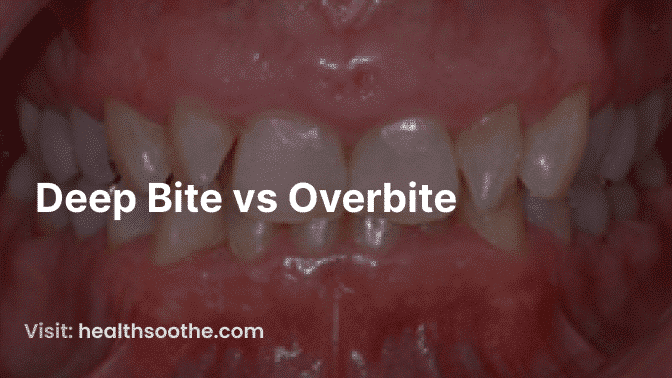The alignment of your teeth and jaws plays an important role in your oral health and overall well-being. One of the most common issues that people face with their teeth and jaws is the misalignment of their bite.
There are two types of bite misalignments that you might have heard of deep bite and overbite. While these terms are sometimes used interchangeably, they actually refer to two distinct types of bite problems.
In this article, we’ll discuss the differences between deep bite and overbite, their causes, and treatment options.
What is Deep Bite?
Deep bite, also known as excessive vertical overlap, occurs when your upper front teeth cover most of your lower front teeth when you bite down.
A normal overbite is about 2-4mm, whereas a deep bite exceeds this measurement. People with deep bite may have difficulty biting into certain foods, experience speech difficulties, and experience jaw pain or tension.
Causes of Deep Bite
There are several factors that can cause deep bite, including:
- Genetics: some people are predisposed to deep bites due to genetic factors.
- Thumb sucking: prolonged thumb sucking during childhood can cause changes in the alignment of the teeth and jaws.
- Malocclusion: any condition that affects the proper alignment of the teeth and jaws can contribute to deep bite, including overcrowding and jaw size discrepancies.
- TMD: People with temporomandibular joint disorders (TMD) may develop deep bites as a result of the stress placed on the jaw joints and muscles.
Effects and Consequences of Deep Bite
If left untreated, the deep bite can lead to a variety of problems, including:
- Tooth wear: because the upper teeth cover the lower teeth, the upper front teeth may wear down more quickly than normal.
- Gum recession: the constant pressure on the gums from the upper front teeth can cause them to recede, which can lead to tooth sensitivity and other oral health issues.
- Jaw pain: the excessive force placed on the jaw joints and muscles can lead to pain and discomfort, as well as headaches and migraines.
- Speech difficulties: Deep bite can affect speech and pronunciation, particularly of sounds that require the teeth to touch, such as “s” and “z”.
Diagnosis and Treatment of Deep Bite
If you suspect that you have a deep bite, it’s important to visit an orthodontist or dentist who can diagnose the condition and recommend treatment options. Some common treatment options for deep bite include:
- Braces: traditional braces can be used to move the teeth into the correct position.
- Invisalign: clear aligners can also be used to treat deep bites, although they may not be as effective as traditional braces.
- Orthognathic surgery: in severe cases, surgery may be necessary to correct deep bites and improve the alignment of the jaw.
What is Overbite?
Overbite, also known as vertical overlap, occurs when your upper front teeth overlap your lower front teeth. A normal overbite is between 2-4mm.
People with overbite may not experience any significant symptoms or problems, but in severe cases, it can cause discomfort and jaw pain.
Causes of Overbite
There are several factors that can contribute to the development of overbite, including:
- Genetics: some people are predisposed to overbite due to genetic factors.
- Thumb sucking: prolonged thumb sucking during childhood can cause changes in the alignment of the teeth and jaws.
- Malocclusion: any condition that affects the proper alignment of the teeth and jaws can contribute to overbite, including overcrowding and jaw size discrepancies.
- Missing teeth: missing teeth can cause the remaining teeth to shift, which can contribute to the development of overbite.
Effects and Consequences of Overbite
In mild cases, overbite may not cause any significant problems. However, in severe cases, it can lead to:
- Chewing difficulties: a significant overbite can make it challenging to bite into and chew certain foods.
- Speech difficulties: overbite can affect speech and pronunciation, particularly of sounds that require the teeth to touch, such as “s” and “z”.
- Tooth wear: the excessive overlap of the upper and lower teeth can lead to accelerated tooth wear and enamel erosion.
- Jaw pain: the misalignment of the jaws can place additional stress on the jaw joints and muscles, leading to discomfort and pain.
Read Also: Understanding Teeth Overbite: Causes, Types, Symptoms, and Treatment Options
Diagnosis and Treatment of Overbite
If you suspect that you have an overbite, it’s important to consult with an orthodontist or dentist who can evaluate your condition and recommend appropriate treatment options. Some common treatment options for overbite include:
- Braces: traditional braces are often used to correct overbite by gradually moving the teeth into the correct position.
- Clear aligners: similar to deep bite, clear aligners can also be used to treat overbite, although their effectiveness may depend on the severity of the condition.
- Orthognathic surgery: in severe cases where the overbite is caused by skeletal issues, orthognathic surgery may be necessary to reposition the jaws.
Prevention and Management of Deep Bite and Overbite
While some causes of deep bite and overbite are beyond our control, there are certain preventive measures and management strategies that can help:
- Early orthodontic intervention: addressing bite issues early in childhood can help prevent the development of more severe problems later on.
- Thumb sucking cessation: if your child sucks their thumb, encourage them to stop the habit to prevent dental and bite problems.
- Regular dental check-ups: regular dental visits allow for early detection and treatment of bite issues.
- Proper oral hygiene: maintaining good oral hygiene habits can help prevent gum disease and other complications associated with deep bites and overbites.
Conclusion
Deep bite and overbite are two distinct types of bite misalignments that can have significant effects on oral health and overall well-being. While deep bite involves the excessive vertical overlap of the front teeth, overbite refers to the vertical overlap of the front teeth.
Understanding the causes, effects, and treatment options for these conditions is crucial for proper diagnosis and effective treatment. If you suspect that you have a deep bite or overbite, it’s recommended to consult with a dental professional who can provide appropriate guidance and treatment tailored to your specific needs.
FAQ 1: Q: What is the difference between a deep bite and an overbite?
A: A deep bite and an overbite are both types of dental malocclusions, but they refer to different types of misalignment. A deep bite, also known as an overbite, occurs when the upper front teeth excessively overlap the lower front teeth vertically. An overbite, on the other hand, refers to the vertical overlap of the upper front teeth over the lower front teeth, regardless of the extent.
FAQ 2: Q: What causes a deep bite or an overbite?
A: A deep bite or an overbite can be caused by various factors, including genetics, improper jaw alignment, prolonged thumb-sucking or pacifier use during childhood, abnormal tooth eruption patterns, or habits such as tongue thrusting or nail-biting. In some cases, skeletal factors may contribute to the development of a deep bite or an overbite.
FAQ 3: Q: Are a deep bite and an overbite considered dental problems?
A: Both a deep bite and an overbite can be considered dental problems if they are severe or cause functional or aesthetic issues. These misalignments can lead to problems such as difficulty chewing, increased risk of tooth wear, speech difficulties, or an unbalanced facial appearance. Treatment may be recommended to address these issues.
FAQ 4: Q: Can a deep bite and an overbite be corrected?
A: Yes, both deep bites and overbites can often be corrected with orthodontic treatment. Braces or clear aligners can be used to gradually reposition the teeth and improve the alignment. In more severe cases, additional treatment options such as orthognathic surgery may be necessary to correct the underlying skeletal discrepancies.
FAQ 5: Q: How can I determine if I have a deep bite or an overbite?
A: A dental professional, such as an orthodontist or a dentist, can diagnose a deep bite or an overbite during a dental examination. They will evaluate the alignment of your teeth, the overlap between your upper and lower front teeth, and the relationship between your upper and lower jaws. X-rays and other diagnostic tools may be used to assess the severity and underlying causes of the misalignment.




